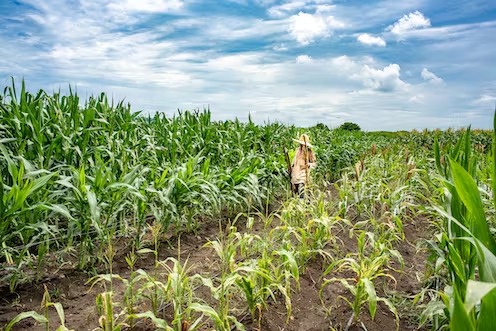For all the attention on flashy new artificial intelligence tools like ChatGPT, the challenges of regulating AI, and doomsday scenarios of superintelligent machines, AI is a useful tool in many fields. In fact, it has enormous potential to benefit humanity.
In agriculture, farmers are increasingly using AI-powered tools to tackle challenges that threaten human health, the environment and food security. Researchers forecast the market for these tools to reach US$12 billion by 2032.
As a researcher studying agricultural and rural policy, I see three promising developments in agricultural AI: federated learning, pest and disease detection and forecasting prices.
Pooling data without sharing it
Robotics, sensors and information technology are increasingly used in agriculture. These tools aim to help farmers improve efficiency and reduce chemical use. In addition, data collected by these tools can be used in software that uses machine learning to improve management systems and decision-making. However, these applications typically require data sharing among stakeholders.
A survey of U.S. farmers found that more than half of respondents said they do not trust federal agencies or private companies with their data. This lack of trust is linked to concerns about sensitive information becoming compromised or being used to manipulate markets and regulations. Machine learning could reduce these concerns.
Federated learning is a technique that trains a machine learning algorithm on data from multiple parties without the parties having to reveal their data to each other. With federated learning, a farmer puts data on a local computer that the algorithm can access rather than sharing the data on a central server. This method increases privacy and reduces the risk of compromise.
If farmers can be persuaded to share their data this way, they can contribute to a collaborative system that helps them make better decisions and meet their sustainability goals. For example, farmers could pool data about conditions for their chickpea crops, and a model trained on all of their data could give each of them better forecasts for their chickpea yields than models trained only on their own data.
An AI-driven giant robot armed with lasers is a major threat – to weeds.
Detecting pests and disease
Farmer livelihoods and global food security are increasingly at risk from plant disease and pests. The Food and Agriculture Organization estimates that worldwide annual losses from disease and pests total $290 billion, with 40% of global crop production affected.
Farmers typically spray crops with chemicals to preempt outbreaks. However, the overuse of these chemicals is linked to harmful effects on human health, soil and water quality and biodiversity. Worryingly, many pathogens are becoming resistant to existing treatments, and developing new ones is proving to be difficult.
Reducing the amount of chemicals used is therefore paramount, and AI may be part of a solution.
The Consortium of International Agricultural Research Centers has created a mobile phone app that identifies pests and disease. The app, “Tumaini,” allows users to upload a photo of a suspected pest or disease, which the AI compares with a database of 50,000 images. The app also provides analysis and can recommend treatment programs.
If used with farm management tools, apps like this can improve farmers’ ability to target their spraying and improve accuracy in deciding how much chemical to use. Ultimately, these efficiencies may reduce pesticide use, lessen the risk of resistance and prevent spillovers that cause harm to both humans and the environment.
Crystal ball for prices
Market volatility and fluctuating prices affect how farmers invest and decide what to grow. This uncertainty can also prevent farmers from taking risks on new developments.
AI can help reduce this uncertainty by forecasting prices. For example, services from companies such as Agtools, Agremo and GeoPard provide AI-powered farm decision tools. These tools allow for real-time analysis of price points and market data and present farmers with data on long-term trends that can help optimize production.
This data allows farmers to react to price changes and allows them to plan more strategically. If farmers’ economic resilience improves, it increases the likelihood that they can invest in new opportunities and technologies that benefit both farms and the larger food system.
AI for good
Human innovation has always produced winners and losers. The dangers of AI are apparent, including biased algorithms, data privacy violations and the manipulation of human behavior. However, it is also a technology that has the potential to solve many problems.
These uses for AI in agriculture are a cause for optimism among farmers. If the agriculture industry can promote the utility of these inventions while developing strong and sensible frameworks to minimize harms, AI can help reduce modern agriculture’s impact on human health and the environment while helping improve global food security in the 21st century.



 Anthropic Reportedly Taps Wilson Sonsini as It Prepares for a Potential 2026 IPO
Anthropic Reportedly Taps Wilson Sonsini as It Prepares for a Potential 2026 IPO  Intel Boosts Malaysia Operations with Additional RM860 Million Investment
Intel Boosts Malaysia Operations with Additional RM860 Million Investment  Taiwan Opposition Criticizes Plan to Block Chinese App Rednote Over Security Concerns
Taiwan Opposition Criticizes Plan to Block Chinese App Rednote Over Security Concerns  Trump Administration to Secure Equity Stake in Pat Gelsinger’s XLight Startup
Trump Administration to Secure Equity Stake in Pat Gelsinger’s XLight Startup  Apple Appoints Amar Subramanya as New Vice President of AI Amid Push to Accelerate Innovation
Apple Appoints Amar Subramanya as New Vice President of AI Amid Push to Accelerate Innovation  OpenAI Moves to Acquire Neptune as It Expands AI Training Capabilities
OpenAI Moves to Acquire Neptune as It Expands AI Training Capabilities  YouTube Agrees to Follow Australia’s New Under-16 Social Media Ban
YouTube Agrees to Follow Australia’s New Under-16 Social Media Ban  Apple Alerts EU Regulators That Apple Ads and Maps Meet DMA Gatekeeper Thresholds
Apple Alerts EU Regulators That Apple Ads and Maps Meet DMA Gatekeeper Thresholds  Hikvision Challenges FCC Rule Tightening Restrictions on Chinese Telecom Equipment
Hikvision Challenges FCC Rule Tightening Restrictions on Chinese Telecom Equipment  AI-Guided Drones Transform Ukraine’s Battlefield Strategy
AI-Guided Drones Transform Ukraine’s Battlefield Strategy  Nexperia Urges China Division to Resume Chip Production as Supply Risks Mount
Nexperia Urges China Division to Resume Chip Production as Supply Risks Mount  EU Prepares Antitrust Probe Into Meta’s AI Integration on WhatsApp
EU Prepares Antitrust Probe Into Meta’s AI Integration on WhatsApp  Morgan Stanley Boosts Nvidia and Broadcom Targets as AI Demand Surges
Morgan Stanley Boosts Nvidia and Broadcom Targets as AI Demand Surges  Baidu Cuts Jobs as AI Competition and Ad Revenue Slump Intensify
Baidu Cuts Jobs as AI Competition and Ad Revenue Slump Intensify  Australia Moves Forward With Teen Social Media Ban as Platforms Begin Lockouts
Australia Moves Forward With Teen Social Media Ban as Platforms Begin Lockouts  TSMC Accuses Former Executive of Leaking Trade Secrets as Taiwan Prosecutors Launch Investigation
TSMC Accuses Former Executive of Leaking Trade Secrets as Taiwan Prosecutors Launch Investigation  Norway’s Wealth Fund Backs Shareholder Push for Microsoft Human-Rights Risk Report
Norway’s Wealth Fund Backs Shareholder Push for Microsoft Human-Rights Risk Report 
































